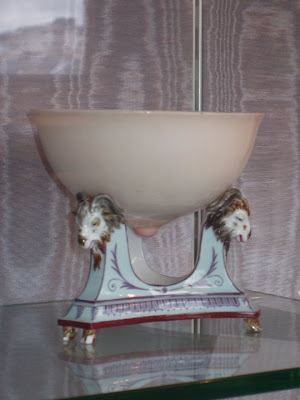Marie Antoinette's Sèvres “Etruscan” style breast cup c, 1788 located at the Musée national de Céramique-Sèvres
In June 1787, Louis XVI surprised his wife Queen Marie Antoinette with a gift - The Laiterie at Rambouillet. The dairy served more as a gift to Marie Antoinette. The domain of Rambouillet was purchased by Louis XVI in 1783 for hunting, and various improvements and alterations were made. Marie Antoinette was not fond of Rambouillet as she thought the place too old fashion and Gothic. The king had hoped that Marie Antoinette would please herself at Ranbouillet playing Dairy maid while he was at one of his favorite things to do, hunting. Inspired by Rousseau and a desire to return to nature, fanciful dairies were very fashionable among the aristocracy of Europe during the late 18th century of the ancien régime, but this Neoclassical dairy designed by Richard Mique would surpass all others. As remarkable as the custom made paintings, sculpture and furnishings that adorned the building itself were the Sèvres porcelain pieces designed to adorn the niches in the antechamber of the Laiterie of the Queen. Neoclassical in design, all of the pieces of the dairy service involved the storage and serving of milk and other dairy products, adhering to the theme of the pleasure dairy - a temple dedicated to milk.
Sixty -five pieces of Sèvres “Etruscan” style porcelain were delivered to Rambouillet in two shipments in 1787 and 1788. Marie Antoinette may have only seen the pieces in the first delivery. Included the 1788 delivery were a set of four Breast cups made for drinking milk from. Famous today because the cups are said to have been molded from the Queen's own breast!
This is not true as the Dairy and all of it's furnishing and decorative arts was to be a surprise to the Queen. The ideal was the kings but his architects and decorators tuck over with the design and planing. Nevertheless the famous Sèvres porcelain cups are two-part tasting bowls, designed for Marie Antoinette to partake of the farm's fresh milk
The cup is in the shape of a breast painted flesh colored with a pink nipple at the bottom. The porcelain breast rest in a Greek style tripod with the head of goats terminating in hoofed feet. The late 18th century Sèvres breast cups makes reference to the traditional Greek mastos cup (from mastos = breast, udder) itself modeled on a breast.
During the Age of Sensibility the aristocracy and Marie Antoinette longed for a sampler life. They looked to a Romanticized peasant life. Marie-Antoinette's laiterie at Rambouillet a temple of milk and cheese was a monument to celebrate peasant life and all that was natural. As the Breast cups make a reference to breast-feeding. Sadly it is only documented that Marie Antoinette might have only seen her Beautiful laiterie at Rambouillet once. During the early 19th century Josephine Bonaparte had Sèvres make the breast cups for herself using the original molds. Josephine's cups were white and gold and were also used in the Rambouillet laiterie. I have been there a few times and will do a post on the building and furnishings. You can see one of Marie Antoinette's breast cups at the Musée national de Céramique-Sèvres where I tuck the first photo.
You can buy copy's of Marie Antoinette's breast cups made by Sèvres directly from its original moulds.
Miniature of Marie Antoinette on ivory by a unknown French artist
Marie Antoinette's Sèvres “Etruscan” style breast cup located at the Musée national de Céramique-Sèvres
Marie Antoinette's Sèvres “Etruscan” style breast cup located at the Musée national de Céramique-Sèvres
An Attic Black-figure Mastos Cup Attributed to Psiax
Terracotta, Late Archaic, ca. 520-510 B.C.E., Attributed to Psiax
A young woman plays the double flutes on the front of this black-figure mastos or breast-shaped cup. The other side of the Mastos cup depicts a woman flourishing a branch and an ivy sprig. These objects, as well as the nebris or animal skin that she wears over one shoulder, identify this woman as a maenad, a female follower of Dionysos, the god of wine. A Dionysiac interpretation applies also to the flute-girl on the front of the mastos, who might be imagined playing for the god and his entourage, or perhaps for the humans honoring the god at a symposium or drinking party.
A mastos was designed for use at just such a symposium. The mastos was a relatively rare cup shape produced by Athenian potters only in the later 500s B.C. The shape fit in with the erotic pleasures of the symposium. Although the nipple on this mastos has been reconstructed, the potter would originally have put a pellet or bead into the nipple so that it rattled as the cup was being used, providing further entertainment.
A modern day copy of Marie Antoinette's famous Sèvres breast cup.






















Have you visited the museum?
ReplyDeleteYes I have been about 6 times!!!
ReplyDeleteThis comment has been removed by the author.
ReplyDelete